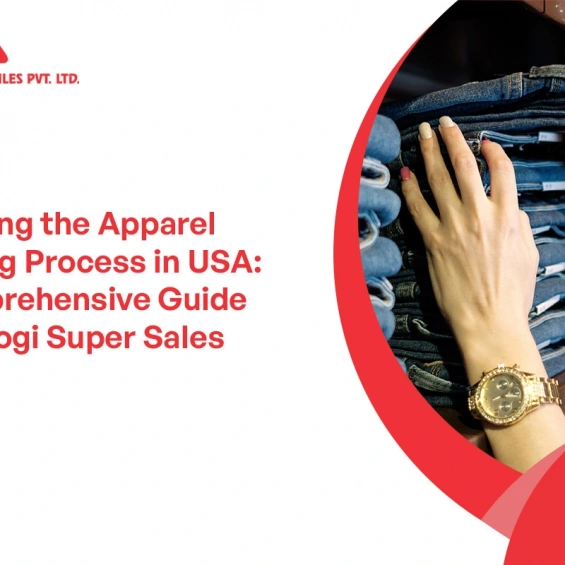Sourcing Fabrics: A Guide to Choosing the Right Materials for Your Apparel Line
Many people prefer sustainable, aesthetic, and ethically sourced fabrics in today’s apparel sourcing, necessitating vigilant fabric selection. They’re also becoming highly concerned about the sources of the material. Therefore, studying the ideal fabric is vital as it impacts the purchase decision and the brand’s position at the forefront of the dynamic apparel textile sourcing in the USA.
In this blog, we’ll dig into the significant influence of fabric choice on consumer preferences and fashion.
How Does Your Fabric Choice Affect Your Garment Sourcing?
The core of your apparel sourcing is the fabric you choose. Whether it’s the softness of silk, the sturdiness of denim, or the comfort of cotton, the fabric determines the attitude. It impacts how the garment drapes breathe and wears over time, in addition to their appearance.
Consumers promoting eco-friendliness attract sustainable materials. Therefore, choosing a fabric that fits consumer expectations is vital. Thus, making sensible choices can determine the popularity and success of your final sourcing.
What Are the Key Factors While Choosing the Right Materials for Your Apparel Sourcing?
Let’s uncover significant factors that help you in selecting the right material for your garment sourcing.
1. Learn Your Brand’s Identity
Start by establishing your brand identity to understand better if the brands are mainly concerned with comfort, sustainability, or a combination of several factors. The material you chose perfectly complements the impression you wish to convey.
2. Know Your Audience
If you want affordability or eco-friendly approaches, you must consider audience values, lifestyles, and preferences. Therefore, you should choose materials that appeal to your target market.
3. Addressing Seasonality
The material you choose will greatly impact the season it will be worn in. Cotton and linen are best for summer because they are light and breathable, while wool and heavier mixes are appropriate for winter.
4. Prioritise Sustainability
Sustainability is gaining importance on a global scale. You should adopt eco-friendly materials like organic cotton, Tencel, or recycled textiles. This applies to consumers who care about eco-friendly approaches and associate your brand with moral behavior.
5. Assessing Comfort and Functionality
You should examine the materials’s breathability and how they feel on the skin. Furthermore, consider the fabric used. For example, stretchy, moisture-wicking textiles are required for activewear, while rigid materials are necessary for formal dress.
6. Keeping Aesthetics and Practicality in Balance
Another factor to consider is that while aesthetics are vital, practicality is also essential. If a beautiful fabric demands a lot of maintenance, creases often, or fades, it can lose appeal. For a well-rounded decision, strike a balance between aesthetics and usefulness.
7. Consider Sampling and Testing
Consistently ask for fabric samples and carry out exhaustive testing. Examine the material responses to several situations, such as washing and wearing. This stage is essential for finding any possible problems and ensuring your garment will last.
8. Budgetary Restriction
Although high-quality materials are sometimes more expensive, consider the long-term benefits above the short-term expenses. Investing in enduring high-quality materials can lower your profits and raise the perception of your brand’s worth.
9. Establishing a Powerful Supplier Relationship
Develop strong connections with fabric suppliers as one line of communication, dependability, and a shared dedication to excellence are critical. Building trust with your suppliers ensures a consistent supply of high-quality products.
10. Staying Up With Trends
Keep an eye out for new fashion trends since staying well-informed helps you keep up with cutting-edge fabric and edging technology that can differentiate your apparel sourcing and attract trend-conscious consumers.
Selecting the proper material is a complex process that requires a detailed study of your brand, your target market, and the distinctive properties of various apparel textiles sourced in the USA. By carefully navigating these factors to promote long-term business success, you’ll create apparel that reflects your vision and connects with your target market.
Also Read : Quality Assurance In Apparel Sourcing: From Samples To Final Products
Material Expertise: Creating Timeless Elegance With the Right Fabrics
The ideal fabric defines fashion while also establishing long-lasting quality and innovation. Therefore, material knowledge is critical in apparel textile sourcing in the USA, weaving everlasting elegance. Consumers want novelty for brands to be influential; therefore, fabric selection is the key to connecting with the target audience’s needs and positioning your brand in the market.
Staying current in this evolving garment sourcing requires developing approaches that align with modern preferences. If you’re looking for a lasting fashion legacy. Contact Saraogi Super Sales, and let your apparel sourcing convey a captivating journey.
FAQ’s
How do you source for fabrics?
Sourcing fabrics involves identifying suitable suppliers, assessing their quality, negotiating terms, and establishing agreements to acquire the required materials for garment production in the apparel industry.
How do we choose the fabrics for our clothing?
What is the process of fabric sourcing?
The process of fabric sourcing involves identifying potential suppliers, evaluating fabric samples for quality and suitability, negotiating terms, and finalizing agreements to secure the required materials for clothing production in the apparel industry.
What are the guidelines for suitable selection of fabrics?
Specializing in sourcing and exporting
a wide range of garments and apparel







